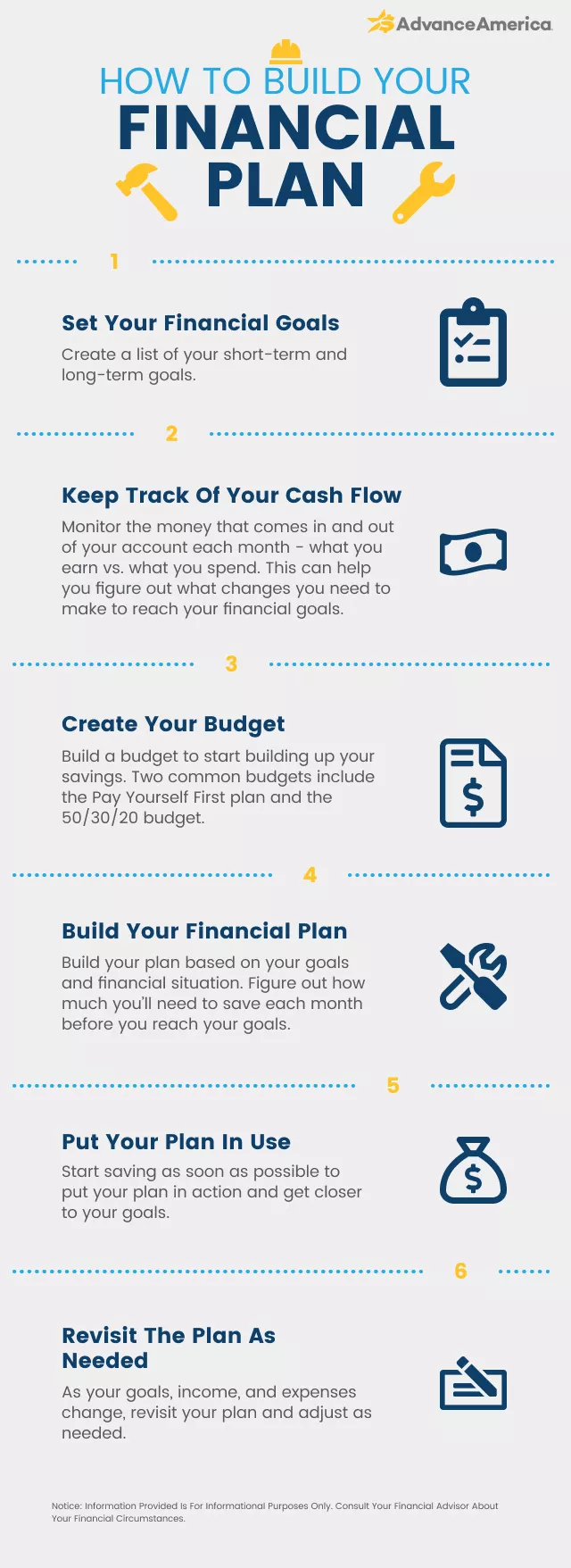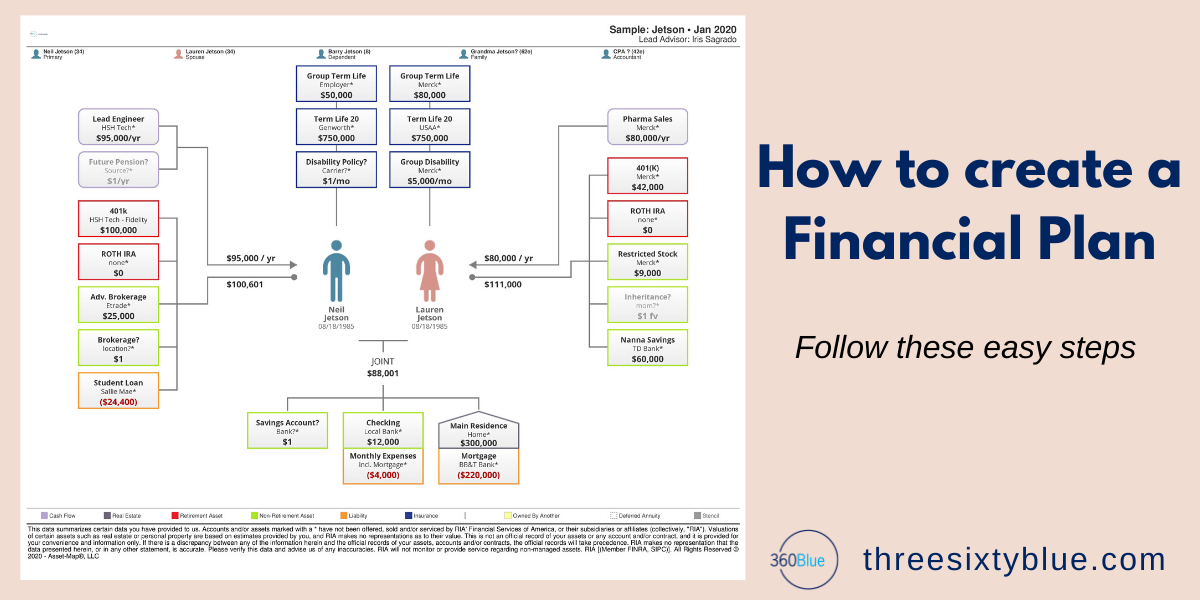Start by setting clear financial goals and creating a detailed budget. Regularly review and adjust your plan to stay on track.
Creating a financial plan is essential for achieving financial stability and growth. It helps you understand your income, expenses, and savings goals. Begin by identifying your short-term and long-term financial objectives. Track your spending habits and create a realistic budget that aligns with your goals.
Regularly monitor your progress and make necessary adjustments to your plan. By staying disciplined and proactive, you can ensure your financial plan remains effective and supports your financial aspirations. This approach not only helps you manage your money better but also reduces financial stress and prepares you for future financial challenges.

Credit: www.advanceamerica.net
Introduction To Financial Planning
Financial planning helps you manage your money wisely. It’s like a roadmap for your financial future. A good plan covers everything from saving money to paying off debt. It can help you reach your goals and feel more secure.
Importance Of Financial Planning
Financial planning is crucial for everyone. It helps you control your money better. With a plan, you can save for big purchases and emergencies. It also helps you avoid unnecessary debt. Below are some reasons why planning is essential:
- Security: A plan makes you feel safe and prepared.
- Goals: Helps you achieve your financial dreams.
- Debt Management: Keeps you from getting into too much debt.
Common Financial Goals
Everyone has different financial goals. Here are some common ones:
- Saving for Retirement: Putting money away for when you stop working.
- Buying a Home: Saving for a down payment and mortgage.
- Education Fund: Saving for your or your children’s education.
- Emergency Fund: Setting aside money for unexpected expenses.
- Debt Repayment: Paying off credit cards or loans.
| Goal | Why It’s Important |
|---|---|
| Saving for Retirement | Ensures you have money when you stop working. |
| Buying a Home | Provides stability and a place to live. |
| Education Fund | Helps pay for school expenses. |
| Emergency Fund | Prepares you for unexpected costs. |
| Debt Repayment | Keeps your finances healthy and stress-free. |
Assess Your Current Financial Situation
To create a solid financial plan, you must first assess your current financial situation. This step helps you understand your financial health and set realistic goals.
Evaluate Income And Expenses
Start by listing all your sources of income. This includes your salary, freelance work, and any side gigs. Next, note down all your expenses. You can use a spreadsheet for this.
| Income | Amount |
|---|---|
| Salary | $4000 |
| Freelance | $1500 |
| Side Gig | $500 |
- Rent: $1200
- Utilities: $200
- Groceries: $300
- Transportation: $150
- Entertainment: $100
Analyze Assets And Liabilities
List your assets such as savings, investments, and property. These are things you own that have value.
- Savings: $10,000
- Investments: $5,000
- Property: $150,000
Next, list your liabilities. These are debts and obligations you owe.
- Mortgage: $100,000
- Credit Card Debt: $5,000
- Student Loans: $20,000
Set Clear Financial Goals
Setting clear financial goals is the first step to financial freedom. It helps you focus and prioritize your spending. Goals give you a roadmap to follow and keep you motivated. Divide your goals into short-term and long-term categories for better management.
Short-term Goals
Short-term goals can be achieved within a year. They are simpler and quicker to accomplish. Some examples are:
- Paying off small debts
- Building an emergency fund
- Saving for a vacation
Create a budget to track your progress. Allocate a portion of your income to each goal. Use apps or spreadsheets to stay organized.
Long-term Goals
Long-term goals take more time to achieve, often years. They require more planning and commitment. Examples include:
- Buying a house
- Saving for retirement
- Funding your child’s education
Break these goals into smaller milestones. This makes them less overwhelming. Review your progress regularly and adjust as needed.
| Goal Type | Examples | Time Frame |
|---|---|---|
| Short-term | Pay off small debts, Save for vacation | Less than a year |
| Long-term | Buy a house, Save for retirement | Several years |

Credit: paperworkllp.com
Create A Budget
Creating a budget is crucial for managing your finances effectively. It helps you understand where your money goes and how to save it. A well-planned budget can lead to financial stability and peace of mind.
Track Spending
Begin by tracking your spending. Write down every penny you spend each day. You can use a notebook or a smartphone app. This will help you see your spending habits. Here is a simple table to help you track your expenses:
| Date | Item | Amount |
|---|---|---|
| 01/01/2023 | Coffee | $3.00 |
| 01/01/2023 | Lunch | $10.00 |
Tracking spending shows you where your money goes. Once you know this, you can make better choices.
Identify Saving Opportunities
After tracking your spending, look for areas to save. Can you make coffee at home instead of buying it? Small changes can lead to big savings.
Here are some tips to identify saving opportunities:
- Cook meals at home
- Cancel unused subscriptions
- Shop with a list to avoid impulse buys
- Use public transport instead of driving
Identifying saving opportunities helps you cut unnecessary expenses. This way, you can save more money each month.
Build An Emergency Fund
Building an emergency fund is crucial for financial stability. It acts as a safety net for unexpected expenses. Here’s how to build one effectively.
Determine Fund Size
First, decide how much you need. Typically, aim for three to six months of living expenses. This amount covers essentials like rent, utilities, groceries, and transportation.
Consider personal factors like job stability, dependents, and health needs. Use the table below to estimate your monthly expenses:
| Expense Category | Estimated Monthly Cost |
|---|---|
| Rent/Mortgage | $1000 |
| Utilities | $200 |
| Groceries | $400 |
| Transportation | $150 |
| Healthcare | $100 |
Total these amounts to find your monthly need. Multiply by three to six for your fund size.
Strategies To Save
Saving can be simple with the right methods. Start by setting a specific savings goal. Automate your savings to ensure consistency.
Consider these strategies:
- Cut unnecessary expenses: Review your budget for areas to trim.
- Use windfalls wisely: Allocate bonuses or tax refunds to your fund.
- Set up a separate account: Keep your emergency fund distinct from other savings.
Track your progress regularly. Adjust your saving methods as needed. Consistency is key for building a robust emergency fund.

Credit: www.threesixtyblue.com
Manage Debt Effectively
Managing debt is crucial for a successful financial plan. Debt can be a heavy burden. It can keep you from reaching your financial goals. By managing debt effectively, you can take control of your finances.
Prioritize High-interest Debt
High-interest debt should be your first priority. It grows faster than other debts. Paying it off first saves you money in the long run.
- List all your debts.
- Identify the ones with the highest interest rates.
- Focus on paying these off first.
Use extra money to pay down high-interest debt. This reduces the total amount you owe over time.
Debt Repayment Strategies
There are several strategies to repay debt. Choose one that works best for you.
| Strategy | Description |
|---|---|
| Snowball Method | Pay off the smallest debt first. Then, move to the next smallest. |
| Avalanche Method | Pay off the highest interest debt first. Then, move to the next highest interest debt. |
| Debt Consolidation | Combine all debts into one. This often has a lower interest rate. |
Each method has its own benefits. Choose one based on your financial situation.
Track your progress. Celebrate small victories. This keeps you motivated to continue.
Invest For The Future
Investing for the future is crucial to building a robust financial plan. By investing wisely, you can grow your wealth and secure your financial stability. This section will guide you through understanding investment options and diversifying investments to maximize returns.
Understand Investment Options
Knowing where to invest is the first step. Different investment options offer various benefits and risks. Here are some common investment options:
- Stocks: Ownership in a company. High risk but high return.
- Bonds: Loans to companies or governments. Lower risk and steady returns.
- Mutual Funds: Pool of stocks or bonds managed by experts.
- Real Estate: Investing in property. Can provide rental income.
- Index Funds: Tracks a market index. Diversified and low-cost.
Choose investments based on your risk tolerance and goals. A balanced approach can help manage risks and optimize returns.
Diversify Investments
Diversification means spreading your money across various investments. This reduces risk and increases potential returns. Here’s how to diversify effectively:
- Mix different asset classes: stocks, bonds, real estate.
- Invest in various sectors: technology, healthcare, finance.
- Consider geographical diversity: domestic and international markets.
Here’s a simple diversification example:
| Investment Type | Percentage of Portfolio |
|---|---|
| Stocks | 50% |
| Bonds | 30% |
| Real Estate | 10% |
| Mutual Funds | 10% |
By diversifying, you protect your investments from market volatility. Diversification helps to balance risks and rewards.
Review And Adjust Your Plan
Creating a financial plan is just the beginning. To ensure it works, you must regularly review and adjust it. Life changes, and so should your financial plan. This section will guide you on how to monitor progress and make necessary adjustments.
Monitor Progress
Regularly check your financial plan’s progress. Set specific times to review your finances. Monthly reviews work well for most people. Use a spreadsheet or financial software. This helps you track income, expenses, and savings. Compare your actual spending with your budget. Identify any deviations and understand why they happened.
| Task | Frequency |
|---|---|
| Review Income | Monthly |
| Check Expenses | Monthly |
| Update Savings Goals | Quarterly |
| Monitor Investments | Quarterly |
Make Necessary Adjustments
Adjust your financial plan as needed. Life events like a new job or baby require changes. Update your budget to reflect new income and expenses. Revisit your savings goals and investment strategies. Ensure they align with your current life stage. If you have more income, consider increasing savings or investments. If facing financial strain, identify areas to cut costs.
- Increase savings if income rises.
- Reduce discretionary spending during tough times.
- Update your emergency fund as your needs change.
- Adjust investment strategies based on market conditions.
Stay flexible and proactive. Regular adjustments ensure your financial plan stays effective. A well-maintained plan helps you reach your goals with less stress.
Frequently Asked Questions
How Do You Create An Effective Financial Plan?
Create an effective financial plan by setting clear goals, tracking expenses, creating a budget, saving and investing wisely, and regularly reviewing your progress.
What Are The Four Main 4 Types Of Financial Planning?
The four main types of financial planning are cash flow planning, investment planning, retirement planning, and tax planning.
What Are The 7 Key Components Of Financial Planning?
The 7 key components of financial planning are budgeting, saving, investing, insurance, tax planning, retirement planning, and estate planning. These elements help manage finances, grow wealth, and secure the future.
What Are The 7 Steps Of Financial Planning?
The 7 steps of financial planning are: establish goals, gather data, analyze information, develop a plan, implement the plan, monitor progress, and review and update regularly.
Conclusion
Crafting a solid financial plan is essential for achieving your financial goals. Stick to your budget, monitor expenses, and adjust as needed. Remember, consistency and discipline are key. By following these steps, you can secure a stable financial future. Start today and watch your financial health improve.

Olga L. Weaver is a distinguished figure in both the realms of real estate and business, embodying a unique blend of expertise in these interconnected domains. With a comprehensive background in real estate development and a strategic understanding of business operations, Olga L. Weaver has positioned herself as a trusted advisor in the complex intersection of property and commerce. Her career is marked by successful ventures in real estate, coupled with a keen ability to integrate sound business principles into property investments. Whether navigating the intricacies of commercial transactions, optimizing property portfolios, or providing strategic insights into market trends, Olga L. Weaver’s expertise encompasses a wide spectrum of both real estate and business-related topics. As a dual expert in real estate and business, she stands as a guiding force, empowering individuals and organizations with the knowledge and strategies needed to thrive in these intertwined landscapes. Olga L. Weaver’s contributions continue to shape the dialogue around the synergy between real estate and business, making her a respected authority in both fields.


